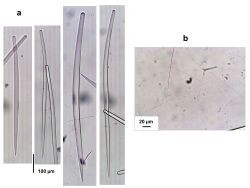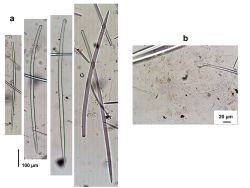orange
orange-yellow
massive
tough
Colombia
Panama
Dragmaxia undata
Description: Orange-yellow, low mounds to low bushes, with all the surface made of irregular hispid projections, often trapping silt. Size up to about 10 cm wide and 3-5 cm thick. Oscules are scattered and often barely visible, appearing as depressed holes in membranes stretching in between protuberances. Out of the water the pinacoderm collapses and the surface becomes more hispid and irregular. Color orange-yellow to orange. Consistency slightly toughly compressible. Ectosome organic, supported by the ends of ascending spicule tracts and brushes. Skeleton conformed by loosely packed ascending, diverging and interconnecting plumose tracts, 2-5 spicules thick, separated up to 20-300 µm and with many spicules strewn in confusion. Megasclere spicules are long but stout styles, curved to slightly bent twice, with sharp and smooth tips, 620-1010 µm long by 7.5-30 µm thick, thicker towards the beginning of the terminal half of the spicule. Microscleres are abundant hair-like raphides, often packed in bundles (called trichodragmata), up to about 225 µm long.
Notes: This is an open deep reef inhabitant, occasionally also seen in cryptic places. Raphide spicules are reported to be ornamented with spines (Alvarez et al., 1998), but these are not discernible under light microscopy. There are other orange and hispid sponge species that could be confused in the field with this species, such as those depicted here under the genus Auletta, and Dictyonella sp. 2-"with oxea"; besides subtle differences in shape and a tendency towards the orange-yellow color, the stout long styles megascleres and the abundant raphides are characteristic of this species.
Author Reference: Alvarez, van Soest & Rützler, 1998
Link: World Porifera Database

![<i>Dragmaxia undata</i> <br />[Colombia, Santa Marta]](mini/00116/01253.jpg)
![<i>Dragmaxia undata</i> <br />[Colombia, Santa Marta]](mini/00115/01835.jpg)
![<i>Dragmaxia undata</i> <br />[Colombia, Santa Marta]](mini/00115/01838.jpg)
![<i>Dragmaxia undata</i> <br />[Colombia, Santa Marta]](mini/00115/01839.jpg)


